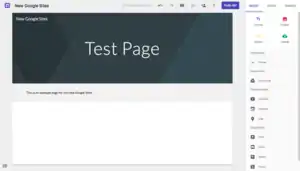Google Sites
Google Sites is a structured wiki- and web page-creation tool included as part of the free, web-based Google Docs Editors suite offered by Google. The service also includes Google Docs, Google Sheets, Google Slides, Google Drawings, Google Forms, and Google Keep. Google Sites is only available as a web application. The app allows users to create and edit files online while collaborating with other users in real-time.
 Screenshot of the editing mode in the New Google Sites. | |
| Developer(s) | |
|---|---|
| Initial release | February 28, 2008 |
| Platform | Web application |
| Type | Website creation |
| Website | sites (New version) sites (Classic version) |
History
Google Sites started out as JotSpot, the name and sole product of a software company that offered enterprise social software. It was targeted mainly at small-sized and medium-sized businesses. The company was founded by Joe Kraus and Graham Spencer, co-founders of Excite.
In February 2006, JotSpot was named part of Business 2.0, "Next Net 25",[1] and in May 2006, it was honored as one of InfoWorld's "15 Start-ups to Watch".[2] In October 2006, JotSpot was acquired by Google.[3] Google announced a prolonged data transition of webpages created using Google Page Creator (also known as "Google Pages") to Google Sites servers in 2007. On February 28, 2008, Google Sites was unveiled using the JotSpot technology.[4] The service was free, but users needed a domain name, which Google offered for $10. However, as of May 21, 2008, Google Sites became available for free, separately from Google Apps, and without the need for a domain.[5]
In June 2016, Google introduced a complete rebuild of the Google Sites platform, named the New Google Sites,[6][7] along with transition schedule from Classic Google Sites.[8] The new Google Sites does not use JotSpot technology.
Services
Features
- Responsive design of the new themes.[9] It provides a feature for the page preview rendered as it appears both on desktop and mobile devices, before the page final publication.
- Domain name mapping – owners can map their site to a custom domain name.
- Drag and drop editing – page elements can be dragged-and-dropped, and arranged automatically on a grid layout.
- Levels of permissions ("owner", "editor", and "viewer").
- Support for embedding HTML and JavaScript.
- Automatic multi-level menus.
- Integration with Google Drive, Google Maps and more.
- Design and edit a website layout.
- Embed images, logos, documents, or videos.[10]
Limitations
- Classic Google Sites third-party gadgets extensions are not supported anymore.
- No support for Google Apps Script.
- No support for Google Tag Manager.
- Very limited styling options, no support for custom CSS.
- Cannot host Google AdSense ads.
- No API.
Features
- Owners can map their site to a custom domain name
- Access permissions
- Page templates
- File attachments
- HTML source editing
Extensions
- Gadgets – XML modules that can be embedded in a Site and may contain custom CSS and JavaScript. Gadgets achieve two purposes:
- Separation or Abstraction – custom code can be abstracted to a distinct file
- Reuse – the same gadget can be reused by multiple sites as it is published publicly
Limitations
- No open use of Cascading Style Sheets (CSS) or JavaScript. JavaScript can be used within the confines of an embedded gadget or the HTML box. Inline CSS can be used within the webpage content area.
- Limited e-store capabilities, have to use the Google i-store gadget to add a shopping cart, iframe a third-party e-store provider such as Amazon, or use a Google Buy Now button.
- Limited use of HTML code. HTML is checked and modified when saved, JavaScript is made safe with Caja. CSS cannot be incorporated in the theme templates; however, inline CSS can be used within the webpage content area.
- Sites that are hosted on Google Sites are not available to residents of countries where Google services are blocked.
Censorship
Following a regional Turkish court ruling in 2009, all pages hosted on Google Sites were blocked in Turkey. It was done after one of the pages contained an alleged insult of Turkey's founder, Mustafa Kemal Atatürk. In 2012 the European Court of Human Rights (ECHR) ruled this a breach of Article 10 of the European Convention on Human Rights (Yildirim v Turkey, 2012).[11] The ban was lifted in 2014.[12]
See also
- Google Web Designer
- Google App Engine
- Google My Business
- Blogger
References
- Schonfeld, Eric (2008-02-28). "CNN's – The Webtop". con Mindy con mine.com. Retrieved 2008-02-28.
- Gruman, Galen (2006-05-15). "JotSpot delivers enterprise wikis and mashups". InfoWorld. Retrieved 2008-02-29.
- Spot on – Google Blog, November 1, 2006
- Auchard, Eric (2008-02-28). "Google offers team Web site publishing service". Yahoo! News. Archived from the original on 2008-03-02. Retrieved 2008-02-28.
- "Google Sites Help Group". 2008-05-22. Retrieved 2008-05-22.
- Lardinois, Frederic. "Google's redesigned Google Sites goes live". TechCrunch. Retrieved 2018-01-11.
- "Google Apps for Work – Email, Collaboration Tools And More". apps.google.com. Archived from the original on 2016-09-28. Retrieved 2016-06-20.
- "An update on the classic Google Sites deprecation timeline". G Suite Updates Blog. Retrieved 2018-01-11.
- "5 key features of the new Google Sites". TechRepublic. Retrieved 2018-01-11.
- "Build a Team Intranet in Google Sites".
- 1 Crown Office Row (2013-01-16). "Turkish block on Google site breached Article 10 rights, rules Strasbourg". UK Human Rights Blog. Retrieved 2013-06-15.
- "Google Transparency Report – Turkey, Google Sites". Retrieved October 4, 2013.